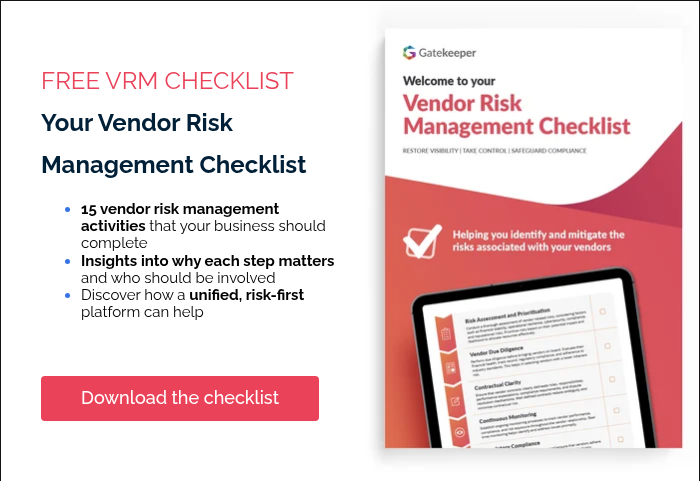What Are the Real Business Costs of Poor Third-Party Risk Management in ANZ?
For compliance-driven organisations across Australia and New Zealand, third-party missteps now trigger costs that hit every corner of the business. These include insurance premiums, service-level erosion, remediation spend, brand dilution, and regulatory enforcement.
The consequences of poor third-party risk management extend beyond fines to affect finances, operations and strategic direction:
1. Financial Penalties
Regulators and insurers now factor supplier resilience into their pricing and oversight, raising the cost of doing business.
In 2025, ANZ Bank absorbed A$240 million in penalties tied to operational control failures - including third-party oversight gaps.
If your vendor governance model can’t demonstrate proactive, risk-first oversight, your capital costs will reflect that exposure.
2. Service disruption fallout
Outages or breakdowns at critical providers undermine customer confidence and invite regulatory scrutiny.
The 2024 global IT outage caused by CrowdStrike didn’t just take systems offline - it dismantled public confidence. In New Zealand, major banks including BNZ suffered cascading outages due to upstream vendor failures.
The lesson: a single blind spot can unravel years of customer trust in a single news cycle.
3. Resource diversion
Teams are pulled into remediation, reporting and crisis response, diverting attention away from forward-looking risk management.
ANZ experienced a major digital-banking outage triggered by issues with a third-party vendor. The bank’s online banking app and Transactive Global systems went down for millions of customers. Staff had to shift immediately into remediation mode - working incident response, vendor investigations, customer communications, system recovery.
A single failure in a vendor relationship pulled significant internal resources into reactive mode, reducing capacity for ongoing vendor oversight and forward-looking risk-avoidance work.
4. Capital impacts
Shareholders and directors press for explanations when outsourcing failures expose the organisation to loss or censure.
ANZ entered into a Court-Enforceable Undertaking (CEU) with Australian Prudential Regulation Authority (APRA) in April 2025, after a review found persistent weaknesses in its non-financial risk management, including oversight of outsourcing/third-party dependencies. APRA increased ANZ’s capital add-on to A$1 billion.
For boards, this underscores that third-party oversight is no longer a backend compliance concern. It's a strategic risk issue that demands clear visibility, auditable controls, and proactive engagement
5. Loss of customer trust
Data breaches, poor labour practices, or unethical subcontractors damage reputation and brand equity. Legal action was initiated against Kmart, earlier this year, alleging some of its products are sourced from factories with links to forced labour camps - effectively putting the brand’s trust and reputation on trial.
What a major institution treats as a manageable supplier setback can, for mid-market firms, become a drain on scarce resources and a brake on growth. For boards, this raises the stakes: third-party governance is no longer a compliance detail, but a measure of corporate discipline and risk maturity.
What Causes Poor Third-Party Risk Management?
Even businesses with strong internal controls often stumble when it comes to supplier management. Three systemic vulnerabilities recur:
- Opaque subcontracting chains: Suppliers relying on multiple layers of subcontractors leave firms exposed to hidden dependencies and ethical risks.
- Concentration risk: Over-reliance on a small number of vendors for critical services such as cloud hosting or payments creates single points of failure.
- Information security gaps: Inconsistent due diligence on service providers handling sensitive data leads to exposures that regulators and customers will not tolerate.
Regulators are watching for evidence of these vulnerabilities. Firms unable to show how they are identifying and mitigating issues risk being marked as high-risk themselves.
What do Regulators Now Expect from Third-Party Oversight?
Firms across ANZ now face a higher bar for supplier governance. Regulators and boards expect oversight to stand up under scrutiny, not just in principle, but in practice. That means delivering outcomes that demonstrate control in ways fragmented systems never can:
- Coherent assurance: Disconnected spreadsheets can’t demonstrate compliance across CPS 230/234, RBNZ outsourcing or privacy rules. Firms need a unified, risk-based framework that boards and regulators can trust.
- Operational continuity: Static supplier reviews miss shifts in vendor health or security. Firms must monitor critical providers continuously to prevent outages or breaches before they escalate.
- Regulator-ready records: Fragmented documentation makes audit defence slow and unconvincing. Evidence must be tied directly to contracts and retrievable instantly across multiple regulatory domains.
- Capacity release: Manual admin work consumes scarce compliance resources. Automation must remove low-value work so lean teams can focus on resilience planning, board engagement, and mitigating strategic risks.
Together, these outcomes give boards the confidence to stand behind their supplier governance, and the proof regulators demand to verify it.
How Does Gatekeeper Help ANZ Firms Meet Regulatory Expectations?
Mid-market firms face an uphill battle to meet and continuously comply with regulatory expectations using spreadsheets and siloed systems that cannot deliver continuous supplier governance.
Meeting this higher bar requires a move away from the ineffective approaches being used. Automation and unification through a dedicated platform are essential for lean mid-market teams to deliver continuous, provable oversight without adding headcount.
Gatekeeper’s unified contract, third-party and spend management platform, powered by its LuminIQ AI agents and MarketIQ risk monitoring, enables firms to readily satisfy regulators and reassure boards.
Here are some typical issues ANZ firms face today, and how Gatekeeper helps to overcome them:
| Issue and Consequences | How Gatekeeper Helps |
|---|---|
| Supplier monitoring is point-in-time, not continuous: Vendors’ financial health, cyber posture, or service reliability can shift rapidly. Weak signals are missed, leading to outages, breaches, or operational disruption. | Operational continuity through live monitoring: Gatekeeper’s integrated MarketIQ engine continuously monitors external risk signals - tracking financial distress, cyber vulnerabilities, and sanctions - so teams can identify emerging threats before they disrupt operations or trigger compliance exposure. |
| Suppliers are treated as equals in onboarding: Critical providers (cloud, data, offshore) may slip through with inadequate controls, while peripheral vendors slow down under unnecessary checks. | Risk-prioritised oversight: Smart Forms and automated workflows tier vendors by business criticality and data sensitivity, ensuring critical vendors face deeper scrutiny while non-critical ones are streamlined. |
| Evidence of supplier governance is fragmented: When CPS 230, RBNZ, or privacy audits arrive, teams scramble to pull documentation from spreadsheets and inboxes, undermining board and regulator confidence. | Regulator-ready records: Evidence is directly linked to contracts and vendor records, producing tamper-proof compliance documentation for multi-regulator demands. |
| Vendor data sits in silos across functions: Inconsistent records mask dependency risks, concentration exposure, and subcontractor chains. Boards lack a true picture of vulnerabilities. | Unified dependency mapping: Gatekeeper consolidates contracts, third party data and spend data into one platform, providing transparency into vendor concentration risk and hidden subcontractors. |
| Lean teams drown in manual admin: Time wasted on attestations, renewals, and reconciliations leaves no capacity for resilience planning or board engagement. | Capacity release through automation: LuminIQ AI agents handle low-value tasks, freeing compliance officers to focus on scenario testing, resilience reporting and strategic risk discussions. |
Where enterprise giants can weather supplier failure as a cost of doing business, mid-sized firms absorb the hit directly - in margin, capacity, and credibility. In today’s environment, third-party governance isn’t a back-office function. It’s a strategic imperative and a measure of organisational discipline.
Gatekeeper helps mid-market organisations:
- Block supplier risk at intake, with automated screening and risk scoring before contracts are signed.
- Accelerate compliant contracting, with guard-railed workflows and AI clause suggestions.
- Maintain continuous audit readiness, with ongoing monitoring and auto-collected artefacts - by design.
This isn’t about checking boxes. It’s about securing the integrity of your entire operating model.
Conclusion
Third-party risk management in ANZ is not a choice. It is a regulatory mandate and a determinant of operational resilience. But firms that approach it as more than compliance can turn it into a competitive advantage.
The future of third-party risk management in ANZ is not about additional checklists or forms. It is about ensuring supplier oversight is a core element of operations, so regulators see control, investors see discipline, and boards can pursue strategy with confidence.
Gatekeeper, powered by LuminIQ, helps ANZ businesses comply with regulations through third-party oversight that is provable, efficient and resilient. Book your demo today to learn how.



.png)
.png)
.png)
-4.png)